  A technical crew member collects a groundwater monitoring well sample, which is screened for hexavalent chromium and other contaminants of concern.
LOS ALAMOS, N.M. – The EM Los Alamos Field Office (EM-LA) and cleanup contractor Newport News Nuclear BWXT Los Alamos (N3B) recently marked the five-year anniversary of the first EM contract dedicated to legacy cleanup at Los Alamos National Laboratory (LANL).
During that time, EM-LA and N3B achieved a number of important accomplishments in protecting water quality, cleaning up Manhattan Project and Cold War sites and shipping waste off-site for permanent disposal.
“N3B has made significant progress in supporting EM-LA’s mission to complete the cleanup of legacy contamination and waste, including controlling the hexavalent chromium plume, increasing the amount of transuranic (TRU) waste shipped to the Waste Isolation Pilot Plant (WIPP) and remediating recently discovered legacy waste at Middle DP Road — a vital part of Los Alamos County’s economic development efforts,” EM-LA Manager Michael Mikolanis said.
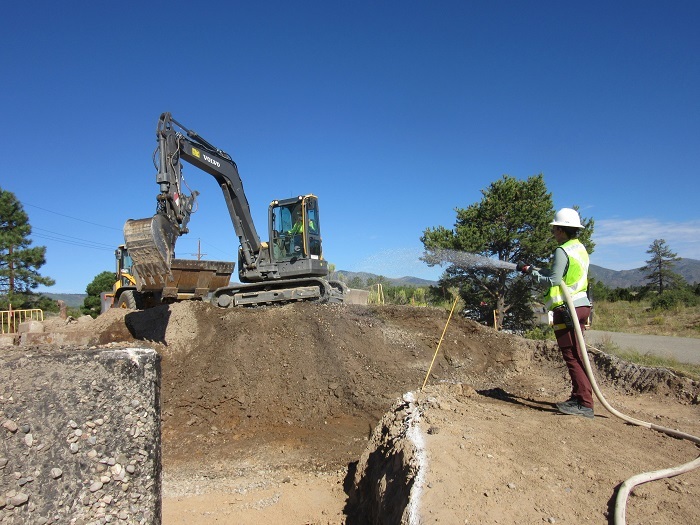 Environmental crew members conduct excavation to clean up contamination in Lower Water Canyon near one of Los Alamos National Laboratory’s Cold War-era underground explosives firing chambers.
Mikolanis said N3B has also been instrumental in partnering with EM-LA to implement regular, ongoing stakeholder and public engagement, which is key to the EM-LA cleanup mission and one of his top priorities.
“I look forward to a continued collaboration with N3B to address new challenges and achieve success for the next cleanup phase,” Mikolanis said.
N3B has operated the chromium interim measures to prevent migration of the hexavalent chromium groundwater plume, which has retreated approximately 500 feet away from LANL’s boundary with the Pueblo de San Ildefonso. As of March, 445 million gallons — approximately 674 Olympic size swimming pools — of contaminated groundwater has been treated. As a secondary benefit of the interim measures, about 700 pounds of hexavalent chromium has been removed from the regional aquifer.
Additionally, under the Aggregate Areas Campaign, a program to address historical contamination across canyons and drainages throughout LANL, N3B has investigated, and remediated as necessary, more than 50% of the contaminated legacy waste sites, collecting more than 19,800 soil and sediment samples.
That effort is central to remediating historical contamination and protecting water quality. In the last five years, N3B has completed 79 of 80 regulatory milestones under the cleanup agreement between DOE and the state of New Mexico, with three fiscal year 2018 milestones having been met prior to the start of the contract.
 At Middle DP Road in Los Alamos — a groundbreaking Manhattan Project-era site for nuclear research and development — crews remove soil and debris contaminated with low levels of radioactivity from historical Los Alamos National Laboratory operations.
Another long-term priority for EM and the state of New Mexico has been shipping waste off-site for permanent disposal. Over the last five years, EM-LA and N3B have made 152 shipments of TRU waste to WIPP. Additionally, the equivalent of 55,147 55-gallon drums of low-level and mixed low-level radioactive waste have been shipped off-site to approved disposal sites, much of this waste from Middle DP Road and the Aggregate Areas.
“The removal, transport and disposal of 634 shipments of low-level and mixed low-level waste to approved disposal sites is central to protecting water quality near LANL, including the Rio Grande, which is a vital water source for local communities,” N3B President and General Manager Brad Smith said.
Smith also noted that in addition to its responsibilities under the legacy cleanup contract, “N3B also made significant contributions to the northern New Mexico economy, including awarding $331 million in business opportunities to subcontractors, 78% of which were small businesses, and donating nearly $2 million to regional non-profit organizations and scholarship programs.”
-Contributors: Estevan Lujan, David Abelson
 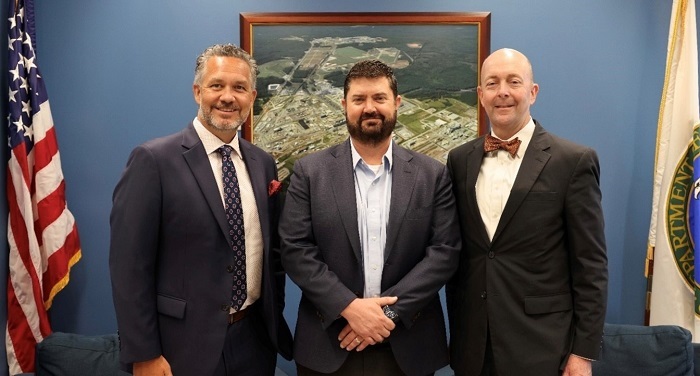
WASHINGTON, D.C. – Jeff Avery, EM’s principal deputy assistant secretary, participated in a meet-and-greet last week in Washington, D.C., with two community partners involved in EM’s cleanup mission at the Savannah River Site in South Carolina. Pictured from left are Robbie Bennett, president and CEO of the Savannah River Community Reuse Organization, Avery, and Will Williams, president and CEO of the Western South Carolina Economic Development Partnership.
  Paducah Site deactivation crews use negative air machines to open sodium fluoride traps. The team removed the trap’s head, which had to be replaced with a fitting for the safe shipment of the equipment.
PADUCAH, Ky. – EM workers continue to reduce chemical hazards at the Paducah Site with the recent shipment of 14 sodium fluoride traps, or exchange vessels, for off-site disposal and the elimination of the site’s entire chlorine gas cylinder inventory.
Removing these hazards reduces their environmental impact and risks to workers and the community. Hazard reduction is one of EM’s key objectives to achieve over the next decade for Paducah.
“Removing the sodium fluoride traps from the site reduced the risk of a chemical release in the C-310 Product Withdrawal facility, a building that previously supported the uranium enrichment process,” Portsmouth/Paducah Project Office Manager Joel Bradburne said.
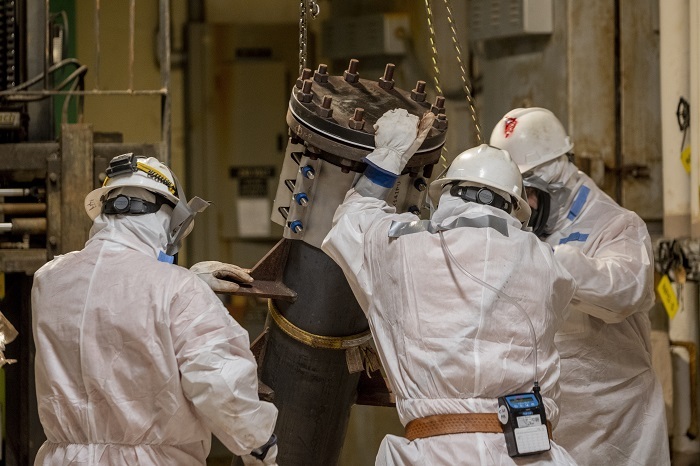 Deactivation crews at the Paducah Site hoist a sodium fluoride trap prepared for packaging and shipment.
 EM workers removed all chlorine cylinders from the Paducah Site, which has advanced EM’s goal to reduce site hazards over the next 10 years.
To prepare the sodium fluoride traps for off-site shipment, workers for Four Rivers Nuclear Partnership (FRNP), EM’s Paducah Site deactivation and remediation contractor, used robust, insulated ovens to heat the uranium hexafluoride contained in the traps so it could be compliantly transferred to storage vessels. The uranium hexafluoride removed from the traps will be sampled and tested to determine if the material can be repurposed for future use.
“To remove the sodium fluoride traps, our team had to utilize complex equipment that had not been used for nearly a decade. That presented challenges that I’m proud to say our team successfully overcame,” FRNP Program Manager Myrna Redfield said.
Paducah eliminated its chlorine gas inventory after FRNP’s recent conversion of the site’s water and sewage treatment plants’ disinfection systems from chlorine gas to sodium hypochlorite, commonly known as household bleach. This allowed the Paducah Site to be removed from state and federal high hazard chemical registers.
“Because sodium hypochlorite poses fewer hazards to workers and the environment, this transition and the removal of the chlorine gas cylinders greatly reduces the amount of surveillance and maintenance activities associated with these systems, which will result in future cost savings,” Bradburne said. “These are opportunities we are looking for as we continue to make progress in our cleanup mission.”
-Contributors: Dylan Nichols, Jessica Vasseur
 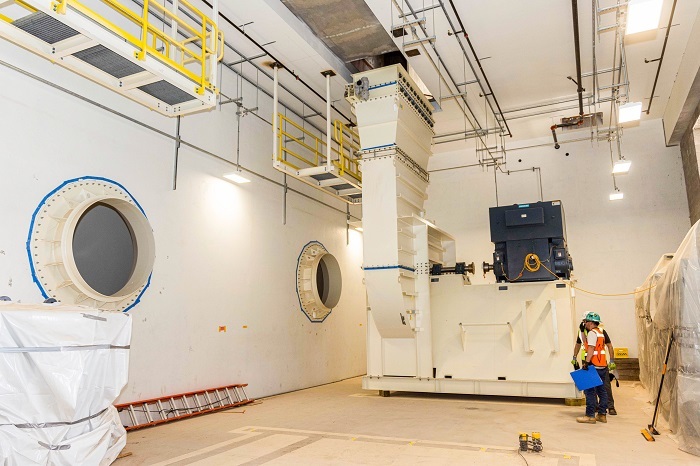 As part of the Safety Significant Confinement Ventilation System, 20-foot-tall exhaust fan assemblies are being placed in the New Filter Building for eventual hookup to the ports at left that come from HEPA filter banks. The 1,000-horsepower motors will pull 540,000 cubic feet per minute of air through the system, compared to the 170,000 cubic feet per minute of filtered air through the current system. Air will be exhausted upward and then out through a 125-foot-tall stack.
CARLSBAD, N.M. – Progress on the Safety Significant Confinement Ventilation System at EM’s Waste Isolation Pilot Plant (WIPP) continues, with crews rapidly approaching the completion of construction of its buildings.
The system is a modern ventilation system designed to move up to 540,000 cubic feet per minute of air through the underground at WIPP, the nation’s only deep geologic repository for defense-related transuranic waste.
The new ventilation system would more than triple airflow, meaning increased capacity for ground-control bolting and mining work while allowing waste emplacement to happen concurrently. Bolting controls the movement of salt rock — known as salt creep — in the WIPP underground.
The ventilation system consists of two structures, the Salt Reduction Building (SRB) and the New Filter Building (NFB). The SRB will prefilter air coming from the underground, dropping salt out of the airflow before it continues to the NFB, where six 1,000-horsepower fans will pull air through 22 banks of HEPA filtration. Up to four of the six fans will operate at a time, with one in standby and one rotated out for maintenance.
The six salt reduction units are fully installed in the SRB, which is expected to be commissioned starting in September. Commissioning entails checking to ensure the fans and other installed systems work properly.
The most dramatic visual changes to the ventilation system are occurring inside the NFB. The 22 switchable HEPA filter housing units have been placed on their bases and are starting to be connected to ductwork. On the other side of the wall inside the NFB, all six massive exhaust fan housings have been moved on to their bases.
Ductwork will connect the filters through a double wall, known as a plenum, to the fans, which will propel air vertically through more ductwork and out to a 125-foot-high exhaust stack. The stack’s first two sections have been installed on its base, and the remainder of the stack is expected to be erected by the end of this month.
“This is going to be a momentous month with so many of the ventilation system’s components coming together. We are excited to see the progress,” said Ralph Musick, a vice president and capital asset projects manager for Salado Isolation Mining Contractors, EM’s management and operations contractor at WIPP.
One of the final parts of the project will take the existing elbow of ductwork coming from the WIPP underground and turn it nearly 90 degrees, away from the existing filter building to connect to the SRB via airborne ductwork.
The switchover to the new ventilation system is scheduled to occur in two years, after the startup phase of the new ventilation system is completed and authorized by EM.
-Contributor: Roy Neese

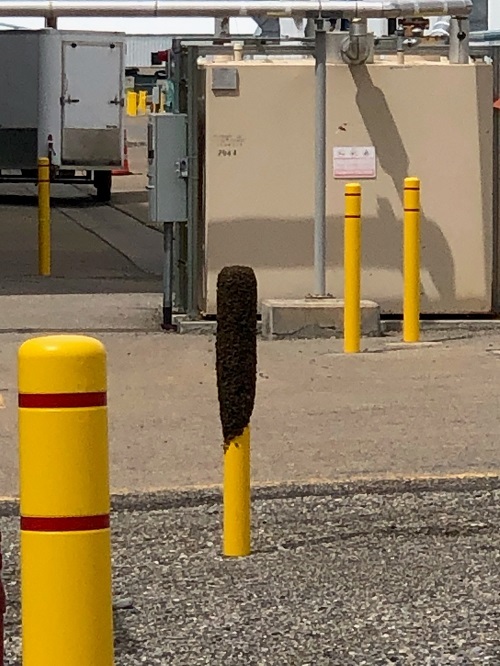 |
|
IDAHO FALLS, Idaho – Alert employees teamed up with a regional beekeeper to save thousands of honeybees that recently took up residence at an Idaho National Laboratory (INL) Site facility and protect members of the workforce from potential, painful stings. Employees with EM contractor Idaho Environmental Coalition (IEC) noticed a massive cluster of honeybees swarming on the southeast portion of the Advanced Mixed Waste Treatment Project (AMWTP). The beekeeper removed the queen bee and the vast majority of the bees followed. He estimated the hive number at 10,000 honeybees. The beekeeper has since relocated the bees to a safe home far away from the AMWTP. |
 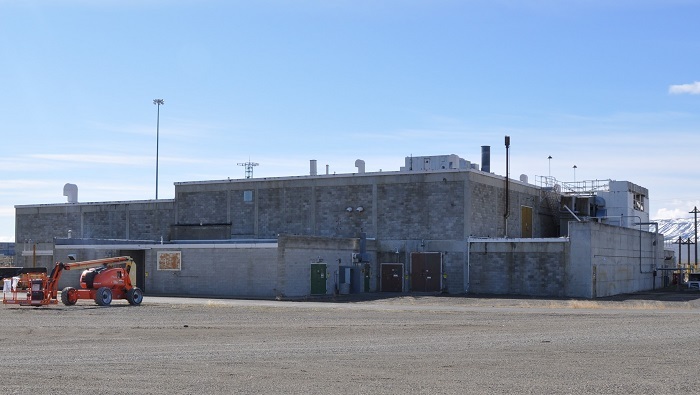 Constructed in 1944, the 231-Z Building served several missions during its 50-year operational lifetime. The building was once among the most heavily secured facilities in the nation when it was used to store refined plutonium for national defense operations.
RICHLAND, Wash. – Crews with EM Richland Operations Office (RL) contractor Central Plateau Cleanup Company (CPCCo) are making progress preparing one of the Hanford Site’s oldest buildings for demolition.
Constructed in 1944, the 231-Z Building served several missions during its 50-year operational lifetime. Its original mission was to refine plutonium as part of national defense operations. It later supported operations at Hanford’s Reduction-Oxidation and Plutonium Uranium Extraction plants.
In 1957, 231-Z was modified to support the plutonium metallurgical program for weapons development, before it was repurposed again in the late 1970s and early 1980s to decontaminate radioactively contaminated equipment. The building was used for office space until it was taken out of service in 1995.
“The historic 231-Z Building is a multifaceted facility, and demolition preparation is an equally complex project,” said Andy Wiborg, RL team lead for Hanford’s Central Plateau Cleanup Project. “Our experienced workforce continues to make safe, steady progress on the building as part of our sitewide effort to reduce risk on Hanford’s Central Plateau.”
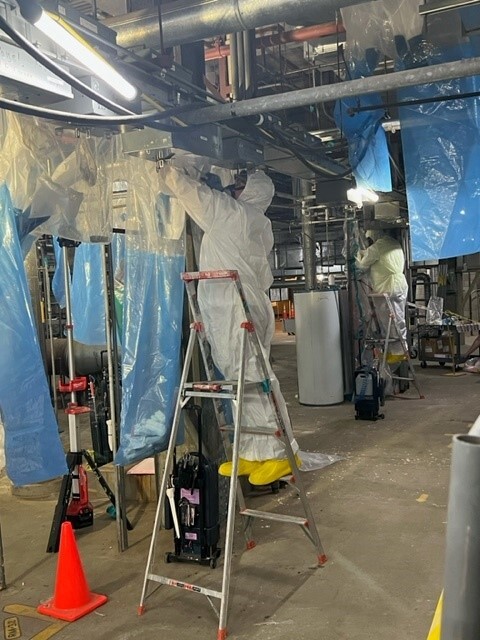
Workers with EM contractor Central Plateau Cleanup Company use glove bags to safely remove asbestos insulation from piping at the 231-Z Building. Crews are preparing the historic Hanford Site building for demolition.
|
For a time, the 231-Z Building was also one of the most secure buildings in the nation, when it housed a heavily guarded vault for storing refined plutonium before it was shipped to Los Alamos National Laboratory in New Mexico for weapons production.
The two-story, 51,500-square-foot building contains numerous laboratories, process cells, ventilation and exhaust systems, distilled water and compressed air systems, as well as storage rooms, change rooms, and offices that need to be cleaned or removed before demolition. The project also involves extensive radiological characterization, removing asbestos and hazardous materials, and disconnecting electrical and mechanical equipment.
“The key to project progress has been excellent teamwork and communication,” said Gary Hix, CPCCo demolition manager for 231-Z. “It’s critical that our field crews and support organizations — engineering, industrial hygiene, radiological controls, safety — are all on the same page. It takes a tight team to make a project like this successful.”
Demolition of the building is expected in 2025.
-Contributor: Mark McKenna
  Avery Newman, a chemical engineering major from Tennessee Tech University, is pictured with newly installed blowers for the Continuous Purge System at the Molten Salt Reactor Experiment facility at Oak Ridge National Laboratory.
OAK RIDGE, Tenn. – With a significant percentage of employees eligible for retirement in the next decade, the Oak Ridge Office of Environmental Management (OREM) and its contractor UCOR are focused on initiatives that will bring interns and graduates into the workforce to learn from experienced personnel before they retire.
As part of this effort, UCOR expanded its internship program this year to 40 participants from 14 colleges across the country.
Born into a family of medical professionals from Mexico, Mauro Perez was expected to follow in family footsteps by becoming a doctor. However, while growing up, he gravitated to Legos and was more interested in building structures.
“After participating in my high school’s STEM program, where I took basic concepts and mechatronics classes, I knew I wanted to spend my future designing buildings and bridges,” Perez said.
Now, his internship has introduced him to a new interest — tearing down structures. One of his assignments includes a project that’s preparing the Alpha-2 facility for demolition at the Y-12 National Security Complex.
The intern program also provides opportunities for students like Andrew Tomassetti.
After spending more than a decade in the U.S. Army, Tomassetti began thinking about his next career while recovering from an injury at Walter Reed National Military Medical Center in Bethesda, Maryland. He thought about the impact of safety on performance operations and decided to pursue a career in quality assurance.
“I was on track to start college courses when a deployment to Afghanistan changed my original plans,” he said.
After receiving medical retirement from the military in 2021, Tomassetti returned to college. He always knew he wanted to spend his civilian life in Tennessee after falling in love with the area during his seven years at Fort Campbell.
In his internship with UCOR, Tomassetti noted the safety culture in which everyone looks after each other.
“My previous experience in aviation, automotive and military all go together in quality assurance where I can put my skills and experience together,” he said.
UCOR’s growing university partnerships have also enabled the company to recruit students to the program more easily.
Andrew Tomassetti, a U.S. Army veteran, is interning with UCOR and is pursuing a career in quality assurance. |
|
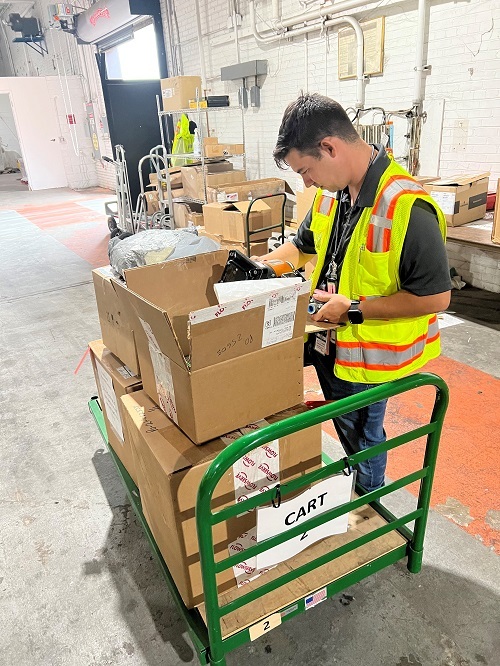 |
Avery Newman, a chemical engineering major from Tennessee Tech University in Cookeville, UCOR’s newest university partner, was familiar with EM’s ongoing environmental cleanup work near her hometown.
“I chose UCOR for my first internship because it provides a diverse opportunity where my values would be aligned with what I want to do while also allowing me to be home for the summer,” said Newman.
She is splitting time between engineering and nuclear safety, which was her goal entering the internship. While classes prepared her for solving calculations, Newman says her position with UCOR provides the experience of a more holistic engineer.
UCOR also expanded intern opportunities into new fields and disciplines this year.
Makayla Hammons, a biomedical engineering major from North Carolina Agricultural and Technical State University in Greensboro, North Carolina, is the first intern assigned to support the health services team in UCOR’s medical clinic.
A Mentorship for Environmental Scholars Program intern undertaking her first internship within DOE, Hammons wanted to learn how the medical world and the environment can intertwine. She’s getting exactly that working with a team that helps the workforce with all work-related injuries, illnesses or medical-related safety issues.
UCOR’s summer internship program pairs college students with mentors in their respective departments, and its proving successful. Several participants have already pursued careers at UCOR after completing their internships. Eleven students from the 2022 class returned for the 2023 session, while eight students joined the UCOR team full time upon graduation.
-Contributor: Shannon Potter
  Mike Budney, manager of DOE’s Savannah River Operations Office, seated, and Jeff Allison, deputy manager of the National Nuclear Security Administration-Savannah River Field Office, discuss the status of Savannah River Site operations.
AIKEN, S.C. – EM contractor Savannah River Nuclear Solutions (SRNS) recently supported the Savannah River Federal Business Opportunities Forum, a two-day event held in North Augusta, South Carolina.
Businesses from multiple states attended the conference, which focused on the diverse, sometimes complex procurement needs of the Savannah River Site (SRS).
After seven years in the making, the forum met its goal, according to Elizabeth Harm, executive director of the Energy, Technology and Environmental Business Association (ETEBA).
“Everyone here is very interested in doing business with SRS. And ETEBA’s mission is to connect businesses with opportunities,” said Harm. “Today’s regional meeting was packed with nearly 300 attendees, and that’s because of the work SRNS and the other site contractors are doing. People want to be a part of it.”
 Jay Johnson, Savannah River Nuclear Solutions (SRNS) deputy vice president of contracts and supply chain management, speaks at the Savannah River Federal Business Opportunities Forum. Panelists also included, from left, Stuart MacVean, SRNS president and CEO; J.C. Wallace, SRNS executive vice president and EM chief operations officer; David Dietz, SRNS supply chain procurement director; and Lisa Tanner, SRNS senior manager of supply chain excellence and small business liaison officer.
SRNS is growing in multiple areas and hiring personnel for its expanding missions.
“To help meet the many procurement challenges presented by a vast increase in work scope, we knew financially supporting and heavily participating in this forum would be of great benefit for us,” said Lisa Tanner, SRNS senior manager of supply chain excellence and small business liaison officer. “At the same time, we genuinely desire to reach out and help those with whom we do business — especially small and minority-owned businesses. Most of those participating in this conference are from small businesses. They are the backbone of our economy, and we put a high value on what they contribute.”
Tanner also noted that the forum offered the opportunity to continue building strong, long-term buyer-supplier relationships. The forum helped SRNS identify areas of expertise among participants.
“ETEBA helps meet the procurement needs of our organization and the needs of a wide range of subcontractors. They act as a liaison to bring us all proactively together. Without them, it would be difficult to hold this type of event,” Tanner said.
“SRNS gets it,” said Harm. “They understand the potential impact of our mission and, for the last six years, have partnered with us for the benefit of numerous businesses, locally and throughout the nation. This forum was founded at their request and will now be an annual opportunity for all.”
Savannah River Mission Completion (SRMC) Chief Administrative Officer Mark Barth and Small Business Program Manager Ashley Hannah presented to ETEBA’s attendees as well, providing insights on how to do business for EM’s liquid waste mission at SRS. SRMC is EM’s liquid waste contractor at SRS.
-Contributor: DT Townsend
 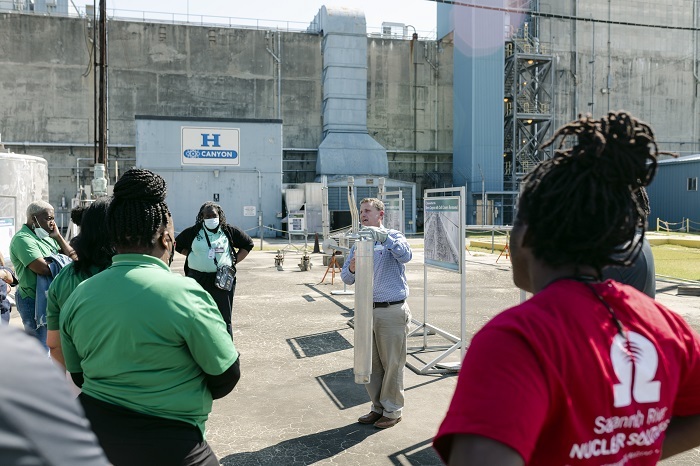 James Therrell, mission planning manager for Savannah River Nuclear Solutions EM operations, discusses vessels and equipment used in H Canyon to educators from Aiken, Orangeburg and Barnwell counties during a tour of the chemical separations facility.
AIKEN, S.C. – Teachers from Aiken, Orangeburg and Barnwell counties in South Carolina recently learned what it takes to successfully lead students to a future in the nuclear industry during the Savannah River Site’s (SRS) first educator tour of the H Canyon Chemical Separations Facility.
“Attending educators were able to witness the scale and variety of work we do inside this national treasure,” said Kim Mitchell, Education Outreach programs lead for Savannah River Nuclear Solutions (SRNS), the site’s management and operations contractor. “Being able to experience H Canyon’s unmatched safety and security culture in a limited security area is a wonderful addition to our educator tours.”
H Canyon began operations in 1955. It’s a one-of-a-kind national asset serving the state, nation and world by processing weapons-grade nuclear materials for disposition out of South Carolina. H Canyon is the only operating, production-scale, radiologically shielded chemical separations facility in the United States, making it a unique tour opportunity.
Barnwell High School Career Specialist Judy “JJ” Cone was impressed by the sheer size of H Canyon.
“This opportunity put into perspective the unique and advanced operations of the site,” said Cone. “I would recommend other educators take part in this tour and gain firsthand knowledge of the types of career specialties available to our students.”
 Barnwell High School Career Specialists Kaylyn Baxley, left, and Judy “JJ” Cone, right, reconnect with Dylan Bowen, who is one of their former students and a Savannah River Site employee, during an H Canyon tour.
The tour provided an overview of operations at SRS with an emphasis on connecting classroom material with future career opportunities at the site.
“It was a full-circle moment running into one of my old students, Dylan, during this tour,” said Kaylyn Baxley, a career specialist with Barnwell High School. “He is a prime example that you can have a secure and well-paying job straight out of high school through the site’s apprenticeship and internship programs.”
SRNS Education Outreach personnel hope to offer more tailored community tours to provide a better understanding of different SRS areas and missions.
“Educators can implement what they experienced during this tour, taking it back into the classroom where it can impact hundreds of students,” said Mitchell. “By utilizing in-person tours, we continue to highlight and promote the positions we need filled that can positively impact the workforce.”
-Contributor: Mackenzie McNabb
  A 53-foot tanker from the K Basins was the first tanker truck at the renovated and expanded Effluent Treatment Facility load-in station on the Hanford Site, to ensure the facility is ready for operation.
RICHLAND, Wash. – EM Office of River Protection (ORP) tank operations contractor Washington River Protection Solutions (WRPS) recently began testing the renovated load-in station at the Effluent Treatment Facility (ETF) to ensure operational readiness. This is another step in preparing to treat tank waste on the Hanford Site.
“Expanding and modernizing the load-in station is a key part of our Direct-Feed Low-Activity Waste (DFLAW) Program for treating tank waste,” said Bibek Tamang, ETF program manager for ORP. “The station prepares us for and will support 24/7 operations on the Hanford Site.”
DFLAW is a collection of interdependent projects and infrastructure, managed as a program, that will operate together to vitrify, or immobilize in glass, low-activity waste for disposal. The ETF is vital to the DFLAW process by removing contaminants from wastewater generated by tank waste activities, groundwater projects, solid waste disposal facilities and other Hanford cleanup activities.
 |
|
Testing is underway at the renovated Effluent Treatment Facility load-in station on the Hanford Site, to verify that the system functions as intended. |
During tank waste treatment operations, the load-in station will handle increased wastewater shipments. Most of the additional wastewater — an estimated 1.2 million gallons a year — will be leachate, or water from rain, snowmelt and dust suppression activities from the Integrated Disposal Facility on the site.
“The building overhaul was expansive,” said Rob Wood, ETF load-in station project manager at WRPS. “We spent six months gutting the old station and installing all new piping, electrical and mechanical equipment. The upgrades nearly double the building’s treatment capacity and will improve efficiency.”
Workers also extended the building by 30 feet to allow room for larger tanker trucks. Crews added new heating, ventilation, and air conditioning components and power and fire suppression systems. They also constructed a new offloading platform to allow tanker drivers to better communicate with facility operators. This modification will also enable an additional tanker to prepare for unloading while another tanker is being emptied.
The next steps for the load-in station include inspections and permitting, with readiness and turnover to operations planned for later this summer.
-Contributor: Joan Lucas
 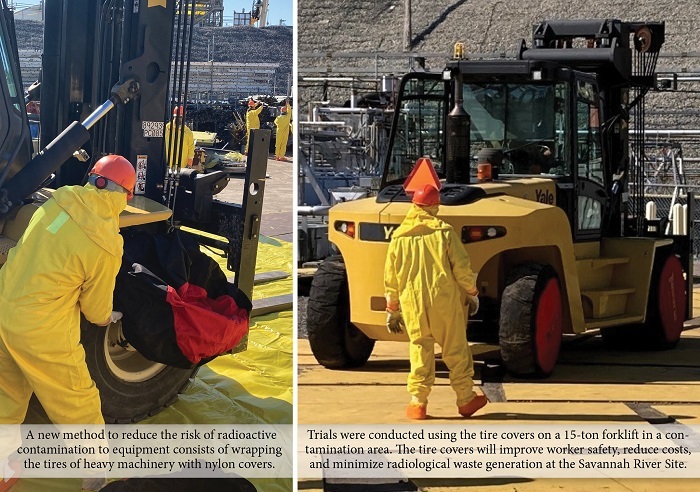
AIKEN, S.C. – EM recently demonstrated an innovative method that is a win for all involved — improving worker safety, reducing construction costs and minimizing radiological waste generation at the Savannah River Site (SRS).
Many projects in the SRS Tank Farms, where the site’s radioactive waste tanks are located, consist of ongoing construction using heavy machinery, like cranes and forklifts. The tank farms are managed by EM liquid waste contractor Savannah River Mission Completion (SRMC).
Previously, for that equipment to work within radiological contamination areas, plastic roadways were constructed to prevent the potential spread of contamination to the tires on the machinery.
While the plastic roadways protect the tires from radiological hazards, they hide potential industrial hazards that pose a threat of slips, trips and falls to workers.
Recently, employees demonstrated a solution to reduce hazards to the workforce and increase overall safety: Instead of laying plastic on the roadways, they placed dual-layer nylon tire covers on the tires of vehicles being used within radiological contamination areas. The tire covers are a heavy-duty material that can stretch over the tires to envelop them completely.
This method was initially tested on a 100-ton crane outside of a radiological contamination area. Additional demonstrations were performed with a 15-ton forklift in a contamination area.
In addition to increasing safety, the tire covers also reduce costs. Their use saves more than $10,000 per equipment entry to radiological contamination areas due to fewer labor hours required for installation and fewer expenses for materials and waste disposal.
The tire covers also minimize radiological waste. It would take 15 uses of the tire covers to match the waste produced by one project using plastic roadways. Using the tire covers reduces waste generation by 93% per project — stopping about 1,250 cubic meters of plastic waste from ending up in landfills every year.
Jim Folk, EM’s assistant manager for waste disposition at SRS, said the tire covers are another example of simple approaches that improve work at SRS.
“Keeping workers safe is the first priority for EM,” Folk said. “This simple idea also saves taxpayers’ money and reduces our impact on the environment.”
This innovation was born out of a bias for continuous improvement, according to SRMC Environment, Safety, Health, and Quality Director Joel Cantrell.
“The liquid waste workforce is proactive when identifying and fixing problems, especially when safety is involved,” Cantrell said. “This new method for safe construction in the tank farms ensures each worker has the ability to return home in the same state that they arrived at work.”
Additional coverings have been ordered for multiple pieces of equipment with the ability to implement immediately upon receipt.
-Contributor: Lindsey Kennedy
 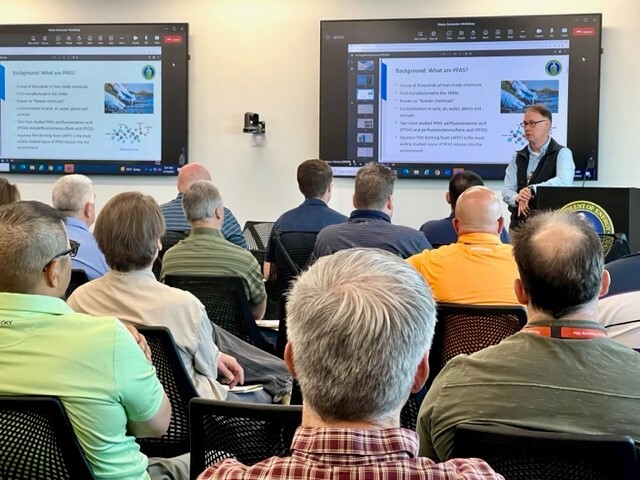 Rob Seifert, acting director for EM's Office of Infrastructure Management and Disposition Policy, presents on per- and polyfluoroalkyl substances (PFAS) during this year’s Waste Generator Workshop in Las Vegas.
Representatives from across the DOE complex gathered in Las Vegas earlier this year to attend the Waste Generator Workshop.
Generators are entities with waste certification programs approved by the Nevada National Security Sites (NNSS) that generate waste in support of DOE and U.S. Department of Defense missions. Workshop participants focused on the transportation, verification and disposal of low-level waste accepted at the NNSS.
EM Nevada Program Manager Rob Boehlecke emphasized the value of bringing partners in the waste disposal process together in person.
“While the sites all talk with the Radioactive Waste Acceptance Program (RWAP) team frequently, we find that gathering everyone in one place, providing breakout meetings and offering overviews on topics that have risen over the course of the year is invaluable,” Boehlecke said. “Communication is key in making sure that waste characterization, packaging, shipping and disposal are handled with the utmost focus on safety and compliance.”
The gathering included three full days of in-depth presentations and targeted meetings. At last year’s workshop, some generators shared lessons learned from their operations that covered an array of topics from packaging to characterization. This was cited as a highlight of the 2022 workshop and several generators agreed to share their experiences at this year’s event. The presentations included lessons learned from issues that arose during the management of waste but also success stories of project planning and execution.
“I am so appreciative of generators sharing their experiences for the benefit of the waste certification community,” said RWAP Manager Marilew Bartling. “Even lessons learned not directly involving NNSS-bound waste are very valuable to the generator community.”
 Participants in this year’s Waste Generator Workshop visited the Sedan Crater while on a tour of the Nevada National Security Sites.
The workshop included updates from the EM Nevada Program, National Nuclear Security Administration Nevada Field Office, EM headquarters and more.
Rob Seifert, acting director for EM's Office of Infrastructure Management and Disposition Policy, gave a briefing on per- and polyfluoroalkyl substances (PFAS), detailing measures to address PFAS at DOE sites while deploying the Department’s scientific expertise to solve PFAS challenges. PFAS are contaminants that migrate into the environment from chemicals used in all types of materials.
Reed Poderis, program manager with Mission Support and Test Services, the NNSS management and operations contractor, gave an update on activities at the Radioactive Waste Management Complex (RWMC), including upcoming enhancements to the real-time radiography equipment planned for fiscal year 2024. Real-time radiography imaging provides a live X-ray feed of the contents of a waste container.
“Reed’s presentation elicited conversation with the generators, which will be very helpful as planning progresses,” Bartling said.
State regulators from the Nevada Division of Environmental Protection also participated in the event, providing information on how they oversee the process of waste coming to Nevada and answering questions from specific sites.
The workshop concluded with a tour of the NNSS. Participants spent a significant amount of time at the RWMC, where they witnessed how shipments are verified and disposed of at the NNSS.
-Contributors: Grant Johnson, Kevin Knapp
 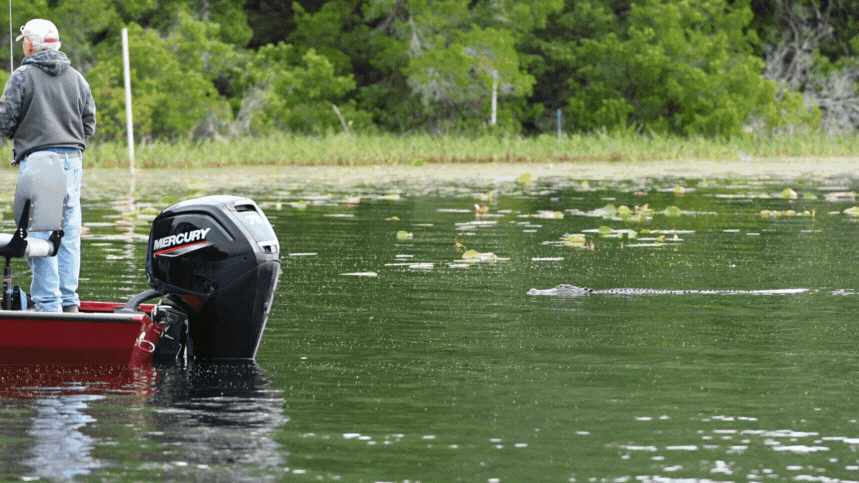
AIKEN, S.C. – Bragging rights weren’t the only thing on the line last month during the 7th Ultimate Fishing Challenge held on Savannah River Site (SRS). Twenty-six military veterans and mobility impaired anglers were paired with experienced fishing escorts from SRS and the broader local community to see which team would take home prizes for catching the biggest fish as well as total weight category. Team Crenshaw took honors for total weight at 11.75 lbs. in the two-fish catch-and-release event. For the first time, three lucky participants teamed up with three professional bass anglers for the competition. The event was hosted by DOE–Savannah River, the U.S. Forest Service-Savannah River and the National Wild Turkey Federation. Other sponsors included SRS contractors Savannah River Nuclear Solutions and Centerra-SRS. To learn more about the fishing event or other recreational events on SRS, contact Forest Service Public Affairs Specialist Joe Orosz at josef.orosz@usda.gov or call (530) 440-9741.
-Contributors: Roger Metz, Josef Orosz
|